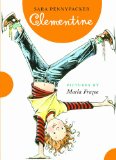Madeline Visits the White House by John Bemelmans Marciano
By Sally Lodge/ Publisher’s Weekly, Jan 27, 2011
“In John Bemelmans Marciano’s Madeline at the White House, 12 little girls arrive—in two straight lines—at 1600 Pennsylvania Avenue just in time for the annual Easter Egg Roll. Along on the trip is Madeline’s magician friend, appearing here as a fez-wearing rabbit, who escorts her and the president’s delighted daughter on a fantastical nighttime tour of Washington. Published this week by Viking, the book evolved from several stories initially conceived by Ludwig Bemelmans, Madeline’s creator and Marciano’s grandfather, who died in 1962.
While looking through his grandfather’s files in preparation for writing 1999’s Bemelmans: The Life and Art of Madeline’s Creator, Marciano found material for a book that Bemelmans had never completed. Entitled Madeline and the Magician, the story brought back the magician introduced inMadeline’s Christmas (which first appeared in McCall’s magazine in 1956 and was published posthumously by Viking in 1985).
“In this new book, the magician was meant to fulfill the girls’ fantasies, but Miss Clavel sends him away and he goes up in a puff of smoke,” says Marciano. “My grandfather had made a sketch of the magician’s fez resting on top of his funeral carriage, which I always thought was such a great image. In the end, the magician transforms himself into a cat wearing a fez, and comes back to stay with the girls.”
Also providing inspiration for Madeline at the White House was another book project Bemelmans had in the works at the time of his death. The author was a friend of Jacqueline Kennedy and, in a series of letters written to her in 1961 and early 1962, he proposed the idea that the two collaborate on a book in which Madeline visits the White House. “The thought was that she would write the text, and the book would be titled Madeline and Caroline, or perhaps Madeline at the White House,” says Marciano. “But it never came to fruition.”

“Since I unearthed the material on both of these projects, I’d been thinking of combining elements of them in a book,” says Marciano. Also fueling his interest in creating Madeline at the White House was his Austrian-born grandfather’s love of his adopted country and of the Washington, D.C. area. “He came to this country as a teenager, and was very proud to become a U.S. citizen,” explains the author. “He served in the army during World War I and is buried in Arlington National Cemetery.” In fitting tribute, the book’s endpapers picture Madeline and her entourage visiting the Tomb of the Unknown Soldier.
Yet another source of inspiration was Marciano’s daughter Galatea, now almost two, to whom Madeline at the White House is dedicated. “It took me 12 years to come up with the right story, and somehow it all came together just about the time she was born,” he recalls. “I became focused on the idea of adding a new little girl to the story.”
That girl, the president’s daughter, is named Candle for the flame-like curl that springs from her head. “My daughter has curly, blondish reddish hair, and when it first grew she had a curl on top of her head that looked like a candle,” explains Marciano. “It occurred to me then that Candle would make a great name for a book character. And lo and behold, the curl became a nice little feature to distinguish the president’s daughter and give her a personality.
Marciano’s editor Regina Hayes, president and publisher of Viking Children’s Books, is thrilled that the author (who also wrote Madeline Says Merci, Madeline Loves Animals, and Madeline and the Cats of Rome) has added to his Madeline oeuvre. “John conveys so wonderfully how important it is to Candle, whose parents are too busy to spend time with her, to find a friend,” she notes. “He has an amazing flair for drawing and captures the characters so well. I love his color sense, but I think his hugest gift is as a caricaturist. His scenes have such exuberance.”
Hayes also praises Marciano’s writing, calling him “as talented a writer as he is an artist.” She has signed up a middle-grade chapter book by the author, The Nine Lives of Alexander Baddenfeld, which introduces a boy who asks a mad scientist to give him extra lives. The not-yet scheduled novel will be illustrated by Sophie Blackall, Marciano’s friend and fellow Brooklynite. “John continues to grow, not just as an artist, but as a writer,” Hayes observes. “He inherited a real gift from his grandfather.”
Marciano will promote Madeline at the White House, which has a 100,000-copy announced first printing, with a 20-city tour. Appropriately, the first leg kicks off in Washington, D.C., with a launch party today at Politics and Prose. The author has created new Madeline art for signage at this spring’s Los Angeles Times Book Festival, where the feisty redheaded heroine will be the featured character.”
That’s all there is. There isn’t any more.








































